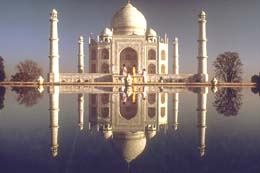Calling all Indians to support me to make Taj Mahal one of the seven Wonders.
By Lakshmi7k
@Lakshmi7k (35)
India
3 responses
@prasad1961 (5597)
• India
26 Dec 06
The Taj Mahal was built on a stretch of land to the south of the walled city of Agra which had belonged to Maharajah Jai Singh: Shah Jahan presented him with a large palace in the centre of Agra in exchange.[5] Construction began with setting foundations for the tomb. An area of roughly three acres was excavated and filled with dirt to reduce seepage from the river. The entire site was levelled to a fixed height about 50 m above the riverbank. The Taj Mahal is 180 feet tall. The dome itself measures 60 feet in diameter and 80 feet high.
In the tomb area, wells were then dug down to the point that water was encountered. These wells were later filled with stone and rubble, forming the basis for the footings of the tomb. An additional well was built to same depth nearby to provide a visual method to track water level changes over time.
Instead of lashed bamboo, the typical scaffolding method, workmen constructed a colossal brick scaffold that mirrored the inner and outer surfaces of the tomb. The scaffold was so enormous that foremen estimated it would take years to dismantle. According to legend, Shah Jahan decreed that anyone could keep bricks taken from the scaffold, and it was dismantled by peasants overnight.
A fifteen-kilometre tamped-earth ramp was built to transport marble and materials from Agra to the construction site. According to contemporary accounts teams of twenty or thirty oxen strained to pull the blocks on specially constructed wagons.







